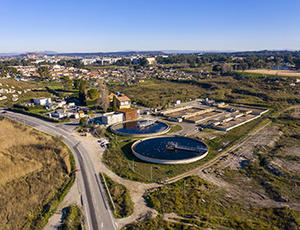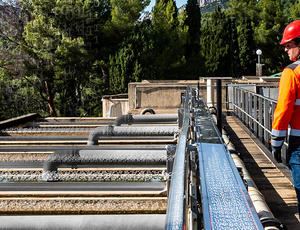Rotopac is an effective technology for dewatering and compacting suspended solids (known collectively as screenings) collected on bar screens and fine screens.
Overview
Rotopac is an effective screw washer compactor for dewatering and compacting the suspended solids (known as screenings) collected on bar screens and fine screens in the wastewater treatment process.
It significantly reduces screening volume by up to 70% and achieves up to 50% dryness, drastically cutting disposal costs and transportation-related emissions. It is suitable for municipal applications.
Rotopac is used in the primary stage of wastewater treatment to remove, dewater and compact screenings captured during the screening process. These materials can include rags, plastics and other debris that could damage downstream equipment or interfere with wastewater treatment processes.
This step is crucial in both maintaining efficiency and ensuring compliance with environmental regulations. Furthermore, savings on handling and transporting screenings can pay back the capital investment in a short time frame as the Rotopac also eliminates problems associated with bad odors, unsanitary handling and disposal costs.
How Rotopac works
Screenings collection
The wastewater first flows through bar screens and fine screens to trap large solids and finer particles such as Cont-Flo® and EscalatorTM. The suspended solids collected are then captured and conveyed to Rotopac for further processing.
The screenings are introduced into the Rotopac feed hopper to start the dewatering and compacting process.
Transport mechanism
A shafted screw mechanism moves the screenings into the compactor which prevents clogging and ensures continuous dewatering operation.
Compaction and dewatering process
Inside the compactor, the screenings are compressed and dewatered using a rotating shafted screw. This reduces the volume of the screenings by squeezing out excess water and air.
The compactor includes a washing stage to reduce bad odors and organic material in the screenings.
Return of filtrate
The water squeezed out during compression is returned to the wastewater channel through a specially constructed drain to be further treated in secondary and tertiary stages, minimizing waste at all stages of the sludge dewatering and suspended solids removal process.
Discharge
The compacted, dewatered screenings are discharged via a discharge duct into a collection container or a bagging system for disposal.
For sanitary and bad odor control purposes, the compactor can be fitted with a screening bagging unit in a number of configurations. The compacted solids are now easier and more cost-effective to transport and dispose of, reducing overall disposal costs and odor pollution.

Features and benefits
Environmental and cost-efficient
- Screenings volume reduced by up to 70%.
- Dewatering screenings can attain up to 50% dryness.
- Dewatered screenings suited for incineration.
- Odors are limited with a completely enclosed system.
- Minimises handling and disposal costs.
Operational excellence and flexibility
- Simple and robust design.
- Can be adapted to any type of screen.
- Simple, compact, fully tested, and proven.
- More than 500 units in operation around the world.
Economic and safe
- Low investment cost.
- Hygienic protection of operating personnel.
Applications
Services
Resources & product range
Rotopac Type RPW
The RPW (Rotopac washing) series provides a cost-effective solution for dewatering, cleaning and compaction of wastewater screenings.
Rotopac Type RLK
The RLK series of screw conveyors provide a cost-effective solution for bulk solids handling.
Contact
By efficiently dewatering and compacting screenings, Rotopac not only improves overall treatment efficiency but also addresses concerns like odor control. Its ability to prepare screenings for incineration further supports circular economy principles. With its simple, robust design and low investment cost, Rotopac demonstrates how smart engineering can simultaneously enhance operational performance, reduce environmental impact, and promote sustainable waste management practices in the water treatment industry.

Bertrand Landry
Application Engineer - John Meunier
Contact Bertrand through his LinkedIn account
FAQ about Rotopac
What are the overall benefits of screening compactors?
- Volume reduction:
Significantly reduces the volume of the screenings and resulting waste, lowering disposal costs.
- Improved hygiene:
Encased systems reduce bad odors and exposure risks to odor pollution.
- Operational efficiency:
Protects downstream equipment from damage caused by suspended solid debris in the wastewater treatment system.
Why is screenings dewatering important in the wastewater treatment process?
Screenings dewatering is vital in wastewater treatment as it reduces the water content of sludge, minimizing its volume and weight. This process lowers transportation and disposal costs, making waste management more efficient and economical.
By producing drier, more manageable screenings, screenings dewatering systems can then dispose of it in an environmentally responsible way, such as incineration, land application, or landfilling.
Additionally, it improves the performance of subsequent treatment processes, reduces odor pollution and contamination risks, and conserves energy.
Case Studies

The wastewater treatment plant in Marionville required a new headworks system as part of a general upgrade strategy to improve process efficiencies and meet state regulations. As part of a comprehensive headworks system supplied by our local experts , the Rotopac screw washer compactor was implemented to handle screenings. By effectively managing the solids removal from the wastewater we helped the City of Marionville to improve the overall efficiency of the treatment process by reducing the volume and dewatering the screenings for easier handling and disposal. This also minimized odors and improved hygiene, contributing to a more efficient and reliable headwork system.






